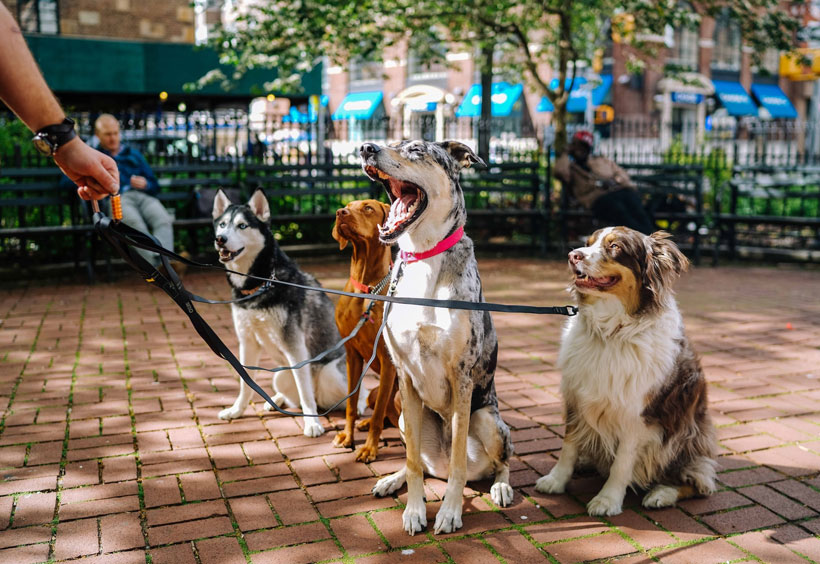How to Start a Dog Walking Business
Sparkpush Editorial Team
Updated November 25, 2023
Edited by: Mike Shelby

Table of Contents
- 1. Introduction
- 2. Market Research and Planning
- 3. Legal and Regulatory Requirements
- 4. Business Name and Branding
- 5. Equipment and Supplies
- 6. Marketing and Promotion
- 7. Client Acquisition and Management
- 8. Daily Operations
- 9. Providing Exceptional Service
- 10. Growing Your Business
- 11. Financial Management
- 12. Ranking the Best States
- 13. Conclusion
Are you passionate about dogs and dreaming of turning that passion into a rewarding business venture? In this comprehensive guide, we’ll walk you through the steps of how to start a dog walking business successfully. From the initial planning stages to providing exceptional service and financial management, we’ve got you covered. Whether you’re a dog lover looking for a new career path or an entrepreneur seeking opportunities in the booming pet care industry, this article will provide you with valuable insights and strategies to embark on your journey.
1. Introduction
A. Brief Overview of the Dog Walking Industry
The dog walking industry has witnessed remarkable growth in recent years, driven by the increasing number of pet owners seeking professional pet care services. Dogs are cherished members of many households, and their owners are often looking for trustworthy and reliable individuals or businesses to ensure their pets receive the exercise and attention they need. This demand has given rise to a thriving dog walking industry, offering ample opportunities for aspiring entrepreneurs.
As pet owners juggle busy schedules, long work hours, and other commitments, they rely on dog walkers to help maintain their furry companions’ physical and mental well-being. Professional dog walkers provide a range of services, including daily walks, playtime, and socialization, which are essential for a dog’s health and happiness.
B. Why Starting a Dog Walking Business Can Be a Rewarding Venture
Starting a dog walking business can be an incredibly rewarding venture for several reasons. First and foremost, it allows you to combine your love for dogs with a sustainable and profitable career. You’ll have the privilege of spending your days outdoors, enjoying the companionship of furry friends, and making a positive impact on their lives.
Additionally, the dog walking industry offers flexibility, making it an attractive option for those seeking work-life balance. Whether you’re looking to launch a part-time endeavor or a full-time business, you can tailor your dog walking services to suit your schedule and goals.
Furthermore, as the pet industry continues to grow, there is ample room for expansion and diversification within the dog walking niche. You can explore additional services such as pet sitting, pet transportation, or even specialized care for dogs with unique needs, thereby increasing your earning potential and serving a broader clientele.
In this guide, we will walk you through the steps to successfully start and manage your own dog walking business, offering insights into the industry’s nuances, legal requirements, marketing strategies, and best practices to help you embark on this fulfilling entrepreneurial journey.
2. Market Research
A. Identifying Your Target Market
Before you embark on your journey to start a successful dog walking business, it’s essential to define your target market. Your target market consists of the specific group of pet owners who are most likely to require your services. By understanding and catering to their needs, you can position your business for success.
Conduct thorough research to identify your ideal clients. Consider factors such as demographics (age, location, income), pet preferences (dog breeds, sizes), and lifestyle (busy professionals, elderly individuals, families). Understanding your target market will help you tailor your services and marketing efforts effectively.
B. Analyzing Local Competition
A comprehensive analysis of your local competition is vital to assess the demand for dog walking services in your area and identify gaps you can fill. Look for existing dog walking businesses, pet care providers, or freelance dog walkers. Analyze their pricing, service offerings, and customer reviews to determine your competitive advantage.
It’s essential to differentiate your business by offering unique value propositions, such as personalized pet care plans, flexible scheduling, or additional services like pet sitting or grooming. Highlighting these distinctions can help you stand out in a crowded market.
C. Setting Pricing Strategies
Determining your pricing strategy is a critical aspect of your business planning process. Consider factors like the cost of operating your business (including insurance, equipment, and marketing expenses) and the prices charged by competitors. Striking the right balance between affordability for pet owners and profitability for your business is key.
Pricing structures can vary, with options such as per-walk rates, monthly packages, or additional charges for extra services. Be transparent about your pricing to build trust with potential clients. Additionally, consider offering discounts or loyalty programs to incentivize repeat business.
D. Creating a Business Plan
Crafting a well-thought-out business plan is the foundation of your dog walking venture. It outlines your business goals, strategies, and financial projections. A comprehensive business plan should include sections on market analysis, competitor research, marketing strategies, financial forecasts, and operational procedures.
Your business plan will serve as a roadmap, guiding your decisions and actions as you launch and grow your dog walking business. It’s a valuable tool for securing financing, attracting potential partners or investors, and keeping your business on track for long-term success.
3. Legal and Regulatory Requirements
A. Business Structure (Sole Proprietorship, LLC, etc.)
Choosing the right business structure is a crucial step in establishing your dog walking business. The structure you select will impact your business’s legal and financial aspects. Common options include:
- Sole Proprietorship: This is the simplest and most common structure for small businesses. As a sole proprietor, you have full control of your business but are personally liable for any debts or legal issues.
- Limited Liability Company (LLC): An LLC offers a degree of personal liability protection while maintaining flexibility in management. It’s a popular choice for many dog walking businesses.
- Corporation: Corporations provide the highest level of liability protection, but they involve more complex legal and financial requirements. They are typically more suitable for larger businesses.
Consult with a legal advisor or accountant to determine which structure best suits your needs, considering factors like liability, taxation, and future growth.
B. Business Licenses and Permits
Complying with local, state, and federal regulations is essential to operate your dog walking business legally. Requirements may vary based on your location, but they often include:
- Business License: Obtain the necessary licenses and permits required by your local government to operate a pet care business.
- Zoning Regulations: Ensure your business complies with zoning laws, as some areas may have restrictions on home-based businesses or pet-related activities.
- Animal Control Regulations: Familiarize yourself with local animal control laws, including leash laws and pet owner responsibilities.
C. Insurance Considerations
Adequate insurance coverage is vital for a dog walking business. Consider the following types of insurance:
- Liability Insurance: Protects you in case of accidents or injuries that occur during dog walks. It covers medical expenses, legal fees, and damages.
- Bonding: A surety bond can provide financial protection in case of theft or property damage.
- Pet Care Insurance: Specialized insurance for pet care providers may cover pet-related incidents, such as bites or injuries to the dogs under your care.
D. Contracts and Liability Waivers
To protect your business and establish clear expectations with clients, create well-drafted contracts and liability waivers. These documents should outline the scope of services, pricing, cancellation policies, and liability disclaimers. Consult with a legal professional to ensure your contracts are legally sound and provide adequate protection for your dog walking business.
By addressing these legal and regulatory requirements, you’ll establish a solid legal foundation for your dog walking business, reduce potential risks, and demonstrate your commitment to professionalism and compliance with clients and authorities alike.
4. Business Name and Branding
A. Choosing a Catchy and Memorable Business Name
Selecting the right name for your dog walking business is a crucial step in building a strong brand identity. Your business name should be catchy, easy to remember, and reflect your services. Consider these tips when choosing a name:
- Relevance: Incorporate words like “paws,” “walk,” or “pets” to clearly convey your business’s purpose.
- Uniqueness: Ensure your chosen name is distinct and not already in use by another local business.
- Memorability: Opt for a name that sticks in the minds of potential clients. Simplicity often works best.
- Domain Availability: Check if a matching domain name is available for your website.
Once you’ve settled on a name, register it with the appropriate local and state authorities to ensure legal compliance.
B. Creating a Logo and Branding Materials
Building a professional brand image is essential for attracting clients and establishing trust. Your logo and branding materials should convey the essence of your dog walking business. Consider the following:
- Logo: Design a logo that features elements related to dogs, walking, or nature. Use colors that evoke feelings of trust and reliability.
- Website: Develop a user-friendly website with information about your services, pricing, and contact details. Optimize it for search engines to improve online visibility.
- Business Cards: Create professional business cards with your logo, contact information, and a brief description of your services.
- Uniform: If you and your team wear uniforms while dog walking, ensure they display your logo and reinforce your brand.
C. Developing a Unique Selling Proposition (USP)
Your Unique Selling Proposition (USP) is what sets your dog walking business apart from competitors. It’s the reason why clients should choose you over others. To develop a compelling USP:
- Identify Your Strengths: Determine what makes your services unique. It could be your experience, personalized approach, or additional services like pet sitting.
- Address Client Needs: Understand your target market’s pain points and tailor your USP to address these needs. For example, if you serve busy professionals, emphasize your flexible scheduling.
- Craft a Clear Message: Create a concise and persuasive statement that communicates your USP to potential clients. This message should be prominent in your marketing materials.
By carefully selecting a business name, creating an appealing brand, and highlighting your unique selling proposition, you’ll establish a strong foundation for your dog walking business and make a lasting impression on clients in your local market.
5. Equipment and Supplies
A. Listing Essential Dog Walking Equipment
To run a successful dog walking business, you’ll need the right equipment and supplies to ensure the safety and well-being of the dogs in your care. Here’s a list of essential items:
- Leashes: Invest in durable, non-retractable leashes of various lengths to accommodate different dog sizes and behaviors.
- Collars and Harnesses: Have a selection of collars and harnesses suitable for various breeds and temperaments.
- Waste Bags: Carry an ample supply of biodegradable waste bags for cleaning up after the dogs during walks.
- Treats: Treats can be useful for rewarding good behavior and training while on walks.
- First Aid Kit: Stock a first aid kit with essentials like bandages, antiseptic wipes, and tweezers for minor injuries.
- Water and Travel Bowls: Keep collapsible water bowls and bottled water to keep dogs hydrated during walks.
- Poop Scooper: Consider a portable, easy-to-clean poop scooper for efficient waste removal.
B. Sourcing Quality Supplies
When sourcing equipment and supplies for your dog walking business, prioritize quality and durability. Invest in products that can withstand daily use and are safe for dogs. Look for reputable suppliers or brands known for their reliability.
Consider establishing relationships with local pet stores or online suppliers that offer bulk discounts or loyalty programs. This can help you save on costs and ensure a steady supply of essentials.
C. Vehicle Considerations (If Applicable)
If your dog walking business involves transporting dogs to parks, trails, or other walking locations, you’ll need a reliable vehicle. Here are some vehicle considerations:
- Safety: Ensure your vehicle is equipped with safety features like secure crates or harnesses to keep dogs safe during transport.
- Ventilation: Proper ventilation is essential to maintain a comfortable temperature for dogs.
- Cleanliness: Keep your vehicle clean and sanitized to provide a safe and hygienic environment for the dogs.
- Licensing: Check local regulations and licensing requirements for pet transport vehicles.
Whether you’re walking dogs on foot or using a vehicle for transportation, having the right equipment and supplies is crucial to delivering top-notch service and ensuring the well-being of the dogs under your care. Prioritize safety and quality to build a reputation as a reliable and professional dog walker.
6. Marketing and Promotion
A. Building a Professional Website
In today’s digital age, a professional website is a cornerstone of your dog walking business’s online presence. Your website serves as a virtual storefront, providing potential clients with essential information and a way to contact you. Here’s what you should include:
- Home Page: A welcoming introduction to your services, featuring engaging content and high-quality images of happy dogs you’ve walked.
- Services: A clear and detailed description of the dog walking services you offer, including pricing and any unique offerings.
- About Us: A brief bio highlighting your experience, qualifications, and passion for dogs.
- Contact Information: Easily accessible contact details, including a contact form for inquiries.
- Testimonials: Showcase client testimonials and reviews to build trust and credibility.
- Blog: Consider a blog where you can share pet care tips, dog-related stories, and insights to position yourself as an expert in the field.
B. Leveraging Social Media Presence
Social media platforms provide an excellent opportunity to connect with potential clients and showcase your love for dogs. Create profiles on platforms like Facebook, Instagram, and Twitter. Regularly post engaging content, such as photos and videos of your dog walks, pet care tips, and client success stories. Engage with your followers and respond promptly to inquiries.
C. Offline Marketing Strategies (Flyers, Business Cards)
While digital marketing is crucial, don’t overlook traditional offline marketing methods. Design eye-catching flyers and business cards to distribute at local pet stores, veterinary clinics, and community bulletin boards. Ensure they contain essential contact information, your website URL, and a compelling message that encourages potential clients to reach out.
D. Networking with Local Pet-Related Businesses
Establishing partnerships with local pet-related businesses can be mutually beneficial. Connect with pet groomers, veterinarians, pet supply stores, and dog trainers. They can refer clients to your services, and you can reciprocate by promoting their businesses on your website and social media profiles.
E. Offering Promotions and Referral Programs
To attract new clients and retain existing ones, consider offering promotions or referral programs. Offer discounts for the first few walks or reward clients who refer new customers. This not only incentivizes loyalty but also encourages word-of-mouth marketing.
By implementing these marketing and promotion strategies, you’ll increase your dog walking business’s visibility, attract a steady stream of clients, and build a strong reputation in your local pet care community.
7. Client Acquisition and Management
A. Creating a Client Onboarding Process
A structured client onboarding process sets the tone for a successful and professional dog walking business. Start by creating a comprehensive welcome package for new clients. This package should include:
- Welcome Letter: A warm introduction and overview of your services.
- Service Agreement: A clear and detailed contract outlining terms, pricing, and expectations for both parties.
- Pet Information Form: Collect essential details about the dogs you’ll be walking, including medical history, behavior, and emergency contacts.
- Contact Information: Ensure you have accurate contact details for your clients, including backup contacts in case of emergencies.
B. Conducting Initial Consultations
Personalized initial consultations are a valuable opportunity to get to know your clients and their pets. During these meetings:
- Ask Questions: Learn about the dog’s personality, routines, and any specific care instructions.
- Share Information: Communicate your experience, qualifications, and the services you provide.
- Establish Trust: Address any concerns or questions the client may have and emphasize your commitment to their pet’s well-being.
- Contract Signing: Review and sign the service agreement, ensuring both parties are clear on terms and expectations.
C. Developing a Scheduling and Payment System
A well-organized scheduling and payment system is essential for smooth operations. Use scheduling software or apps to efficiently manage appointments and client information. Implement a transparent payment process with options for online payments, invoices, and recurring billing for regular clients. Clearly communicate your billing cycles and payment deadlines.
D. Building Client Relationships and Trust
Building strong relationships and trust with your clients is key to client retention and positive referrals. Maintain open and transparent communication:
- Regular Updates: Provide clients with updates after each walk, including photos and notes about their dog’s behavior and activities.
- Flexibility: Be accommodating with scheduling changes and last-minute requests when possible.
- Responsive: Respond promptly to messages and inquiries, demonstrating your dedication to their pet’s well-being.
E. Handling Emergencies and Special Requests
Preparedness is essential when dealing with emergencies or special requests. Develop a contingency plan for situations such as lost keys, medical emergencies, or sudden changes in a dog’s behavior. Ensure you have access to emergency contact information, including veterinarians and backup pet caregivers.
By implementing a well-structured client acquisition and management process, you’ll not only attract and retain clients but also provide exceptional service that fosters trust and confidence in your dog walking business.
8. Daily Operations
A. Planning and Scheduling Dog Walks
Effective planning and scheduling are the heart of daily operations for your dog walking business. Create a systematic approach to managing your appointments and optimizing your routes. Here’s how:
- Calendar Software: Utilize digital calendar tools or specialized pet-sitting software to manage your appointments efficiently.
- Route Optimization: Plan your routes to minimize travel time between clients’ homes and maximize the number of walks you can complete in a day.
- Flexible Scheduling: Be accommodating with client requests for walk times, but also establish clear boundaries to maintain an organized schedule.
B. Safety Protocols and Handling Different Dog Temperaments
Ensuring the safety of the dogs under your care is your top priority. Implement these safety protocols:
- Leash Handling: Use sturdy, non-retractable leashes to maintain control during walks.
- Temperament Assessment: Evaluate each dog’s temperament and behavior to anticipate any potential issues. Be prepared to handle various temperaments, from overly energetic to shy or anxious.
- Group Walks: If you offer group walks, carefully select dogs with compatible temperaments to avoid conflicts.
- Emergency Equipment: Carry a basic first aid kit and know how to administer basic first aid in case of minor injuries.
C. Record-Keeping and Tracking Client Information
Accurate record-keeping is essential for managing your dog walking business effectively. Create a system to track client information and dog-specific details:
- Client Profiles: Maintain detailed client profiles, including contact information, pet preferences, and special instructions.
- Walk Logs: Record information about each walk, including the date, duration, distance, and any noteworthy observations.
- Medical Records: Keep copies of vaccination records, emergency contacts, and relevant medical history for each dog.
D. Managing Unexpected Situations (Lost Keys, Injuries, etc.)
Be prepared to handle unexpected situations that may arise during dog walks:
- Lost Keys: Develop a procedure for handling lost keys, such as contacting the client immediately and following their instructions.
- Injuries or Illness: Have a plan in place for responding to injuries or illnesses that may occur while walking a dog, including contacting the client and seeking veterinary care if needed.
- Unforeseen Events: Prepare for unforeseen events like extreme weather conditions or aggressive encounters with other animals. Have a backup plan to ensure the dog’s safety.
By efficiently managing your daily operations, adhering to safety protocols, and maintaining meticulous record-keeping, you’ll provide reliable and professional dog walking services that clients can trust. This dedication to excellence will set your business apart and lead to satisfied clients and repeat business.
9. Providing Exceptional Service
A. Tips for Engaging with Dogs During Walks
Engaging with dogs during walks is not just a job—it’s an opportunity to create a positive and enriching experience for your four-legged clients. Here are some tips for providing exceptional service:
- Use Positive Reinforcement: Reward good behavior with treats and praise to reinforce positive habits.
- Be Attentive: Pay close attention to the dog’s body language to gauge their comfort and mood during the walk.
- Interactive Play: Incorporate interactive play, like fetch or tug-of-war, to keep the walk engaging and fun.
- Vary Routes: Change up your walking routes to provide new sights and smells, preventing boredom.
- Tailor Pace: Adjust your walking pace to match the dog’s energy level. Some dogs may prefer a leisurely stroll, while others may need a brisker walk.
B. Understanding and Meeting Pet Owners’ Expectations
Pet owners entrust you with the well-being of their furry family members, so it’s essential to understand and meet their expectations:
- Communication: Maintain open and clear communication with pet owners. Provide updates, photos, and notes after each walk to keep them informed and reassured.
- Customized Care: Tailor your services to meet the specific needs of each dog. Be attentive to dietary restrictions, medications, and exercise requirements.
- Reliability: Always arrive on time for scheduled walks and appointments. Consistency builds trust with pet owners.
- Flexibility: Be accommodating when pet owners request changes in scheduling or additional services, within reason.
C. Going the Extra Mile to Exceed Client Satisfaction
To differentiate your dog walking business and foster client loyalty, consider going the extra mile to exceed client satisfaction:
- Personalized Touch: Remember special occasions like birthdays and holidays, and consider small gestures like leaving a personalized note or a treat for the dog.
- Training and Socialization: Offer tips and guidance on training and socialization to help improve the dog’s behavior and overall well-being.
- Loyalty Rewards: Implement a loyalty program that rewards repeat clients with discounts or exclusive perks.
- Client Feedback: Solicit and welcome feedback from clients to continuously improve your services and address any concerns.
Providing exceptional service not only ensures the happiness and safety of the dogs you walk but also builds strong client relationships and enhances your reputation within the pet care community. Happy dogs and satisfied clients are the keys to the long-term success of your dog walking business.
10. Growing Your Business
A. Scaling Your Operations (Hiring Employees or Subcontractors)
As your dog walking business thrives, you may consider scaling your operations to meet increasing demand. Scaling can involve hiring employees or subcontractors to help with the workload. Here’s how to do it effectively:
- Recruitment: Carefully select individuals who share your passion for dogs and align with your business values. Ensure they have the necessary skills and experience.
- Training: Provide comprehensive training to new team members to ensure they understand your service standards, safety protocols, and client expectations.
- Supervision: Maintain oversight of your employees or subcontractors to ensure quality control and consistency in service delivery.
- Legal Considerations: Consult legal advisors to understand your responsibilities as an employer or contractor, including tax and insurance obligations.
B. Expanding Services (Pet Sitting, Pet Transportation, etc.)
Expanding your service offerings can be a strategic way to grow your dog walking business. Consider adding services like pet sitting, pet transportation, or specialized care for dogs with unique needs. Here’s how:
- Market Research: Identify the demand for additional services in your area and assess the competition.
- Training: Ensure you and your team are adequately trained and certified for any new services you offer.
- Pricing Structure: Set competitive prices for new services while maintaining profitability.
- Marketing: Update your website and marketing materials to promote your expanded services and inform existing clients.
C. Seeking Client Feedback and Testimonials
Valuable feedback from your clients can help you improve your services and build trust. Encourage clients to provide feedback and testimonials:
- Feedback Forms: Send surveys or feedback forms to clients periodically to gather their input on your services.
- Testimonials: Request clients to share positive experiences on your website or social media platforms.
- Implement Changes: Use client feedback to make necessary improvements and demonstrate your commitment to excellence.
D. Measuring and Analyzing Business Performance
Regularly measuring and analyzing your business performance is essential for making informed decisions and achieving growth. Consider these steps:
- Key Performance Indicators (KPIs): Define KPIs such as client acquisition rate, client retention rate, and revenue growth.
- Tracking Tools: Use accounting software, scheduling software, and analytics tools to monitor financial performance and customer data.
- Business Goals: Set specific, measurable, and achievable goals to guide your business’s growth strategy.
- Adaptation: Continuously adapt your strategies based on performance data to optimize your business for success.
By scaling your operations, expanding services, seeking client feedback, and analyzing your business performance, you’ll be well-positioned to take your dog walking business to the next level and ensure its long-term success in the pet care industry.
11. Financial Management
A. Budgeting and Managing Expenses
Effective financial management is crucial for the sustainability of your dog walking business. Start by creating a detailed budget that accounts for all your expenses, including:
- Operating Costs: This includes expenses like insurance, licensing fees, marketing, and pet care supplies.
- Labor Costs: If you have employees or subcontractors, calculate their salaries or wages.
- Transportation Costs: Include expenses related to vehicle maintenance, fuel, and insurance if you use a vehicle for dog transportation.
- Taxes: Set aside a portion of your income for taxes, including income tax and, if applicable, self-employment tax.
- Emergency Fund: Maintain an emergency fund to cover unexpected expenses like vehicle repairs or medical emergencies.
Regularly review your budget and identify areas where you can optimize spending and reduce costs to increase profitability.
B. Keeping Track of Income and Taxes
Accurate financial record-keeping is essential to understand your business’s financial health and fulfill tax obligations. Here’s how to manage income and taxes effectively:
- Separate Business and Personal Finances: Maintain separate bank accounts for your business to keep transactions clear and organized.
- Record All Income: Ensure you accurately record all income from dog walking services and any additional services you offer.
- Expense Tracking: Keep meticulous records of all business-related expenses, including receipts and invoices.
- Estimated Taxes: Calculate and pay estimated taxes quarterly to avoid penalties and stay compliant with tax authorities.
- Seek Professional Help: Consider hiring an accountant or tax advisor with experience in small businesses to help with tax planning and preparation.
C. Setting Financial Goals and Benchmarks
Establishing clear financial goals and benchmarks provides direction and motivation for your business. Consider the following steps:
- Define Goals: Set specific financial goals, such as revenue targets, profit margins, or savings objectives.
- Break Down Goals: Divide larger goals into smaller, manageable milestones to track progress.
- Monitor Progress: Regularly review your financial statements and assess whether you’re on track to meet your goals.
- Adjust Strategies: If necessary, adjust your business strategies to align with your financial objectives.
By actively managing your finances, budgeting effectively, and setting achievable financial goals, you’ll not only ensure the financial health of your dog walking business but also work toward long-term financial success and stability.
Now that you’ve gained a comprehensive understanding of the key aspects involved in starting and running a successful dog walking business, let’s delve deeper into the specific geographical considerations. In this chapter, we’ll rank and explore the best states for launching your dog walking venture, taking into account various factors that can significantly impact your success.
12. Ranking the Best States to Start a Dog Walking Business
When it comes to starting a dog walking business, location matters. The state you choose to launch your venture can greatly influence your business’s potential for success. Factors such as population density, pet ownership rates, and regulatory environment can vary significantly from one state to another, impacting the demand for your services and the ease of doing business.
13. Conclusion
A. Summarizing Key Steps to Start and Run a Successful Dog Walking Business
Starting and running a successful dog walking business can be a fulfilling and rewarding venture. To recap, here are the key steps you should follow:
- Market Research and Planning: Identify your target market, analyze competition, set pricing strategies, and create a comprehensive business plan.
- Legal and Regulatory Requirements: Choose the right business structure, obtain necessary licenses and permits, secure insurance coverage, and establish clear contracts and liability waivers.
- Business Name and Branding: Select a memorable business name, create a distinctive logo and branding materials, and develop a unique selling proposition (USP).
- Equipment and Supplies: Equip yourself with essential dog walking equipment, source quality supplies, and consider vehicle requirements if applicable.
- Marketing and Promotion: Build a professional website, leverage social media, utilize offline marketing strategies, network with local pet-related businesses, and offer promotions and referral programs.
- Client Acquisition and Management: Create a client onboarding process, conduct initial consultations, develop scheduling and payment systems, build client relationships, and be prepared to handle emergencies and special requests.
- Providing Exceptional Service: Engage with dogs during walks, understand and meet pet owners’ expectations, and go the extra mile to exceed client satisfaction.
- Growing Your Business: Scale your operations, expand services, seek client feedback and testimonials, and measure and analyze business performance.
- Financial Management: Budget and manage expenses, track income and taxes, and set financial goals and benchmarks.
B. Encouraging Entrepreneurship and a Passion for Working with Dogs
Embarking on the journey of starting a dog walking business not only offers you the opportunity to pursue your passion for dogs but also to build a thriving entrepreneurial endeavor. It’s a chance to make a positive impact on the lives of both dogs and their owners while crafting a career that aligns with your interests.
Remember that success in the dog walking business requires dedication, professionalism, and a genuine love for dogs. Continuously educate yourself, stay updated with industry trends, and prioritize the well-being of the pets you care for. With the right mindset, a solid plan, and unwavering commitment, you can create a flourishing dog walking business that brings joy and satisfaction to both you and your clients.









